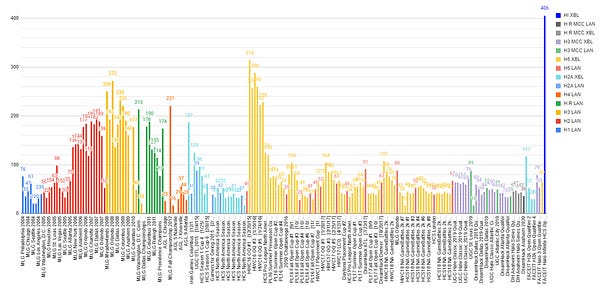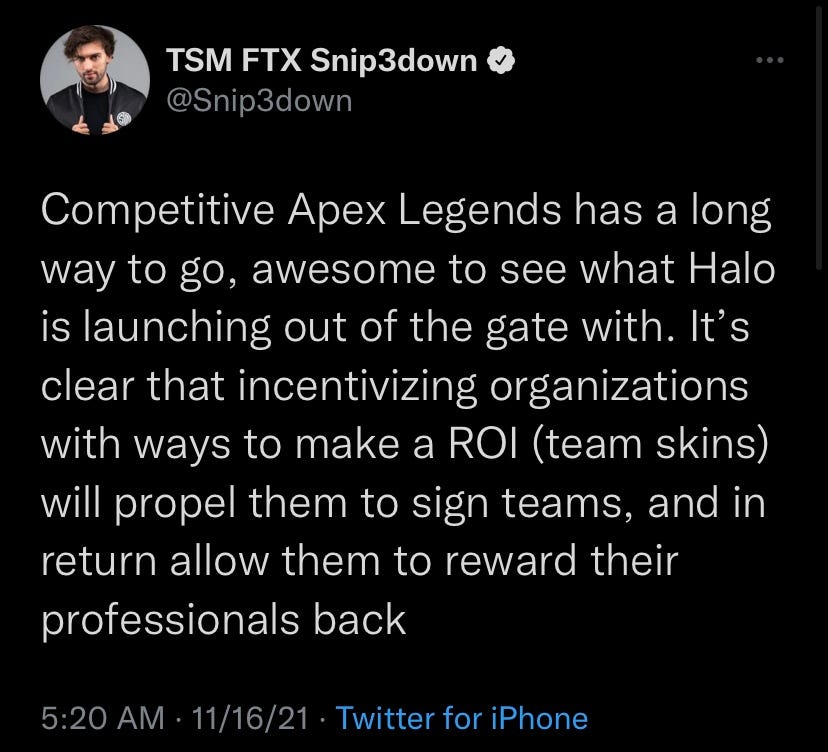The 1000-pound supersoldier in the room
The launch of Halo Infinite proves that the old geezer still has a say in the future of esports
The long-delayed Halo Infinite launched its multiplayer beta early, largely without hiccups. There was no surprise Battle Royale mode. No big twists. Instead, Halo Infinite delivered a huge dose of nostalgia. It plays like a slick, modern version of the same game I first booted up on an original Xbox 20 years ago, wrapping my child-sized hands around a controller the size of my head. Sure, there were some concessions to the changing times. 343 threw in Pathfinder’s grapple, but souped it up by letting Spartans grab items and power-ups with it. Fair enough—Arc Stars are to plasma grenades as Greta Van Fleet is to Led Zeppelin. There are some new weapons. Everything else is familiar: the same sword, the same rocket launcher, the same melee trades.
Is it good or bad that Halo Infinite is largely retreading its own cultural tank tracks? That’s not for me to say. But it is clear that the Halo Infinite esports scene is primed to draw deeply from that well of nostalgia. This is an esport with a base of gamers who are in their twenties and thirties, who have a long-term relationship with the franchise and whose large wallets are coveted by advertisers.
While friends who watch competitive Apex report that they are bored by Halo esports, it is easier to understand and spectate than Apex, and it has a blue-chip appeal built over decades.
406 teams signed up to play in the first HCS (Halo Championship Series) Open, a massive event that boasted a prize pool of… $2000. While teams were also awarded qualification points toward the $250,000 HCS Raleigh LAN in December, the competitive hype far outweighed any material award from the tournament.
The event broadcast peaked at around 56,000 viewers on Twitch. To compare it to ALGS viewership, that means a $2000 qualifying tournament reached only slightly fewer viewers than the ALGS Championship streams this summer, and roughly matched the viewership of the last LAN the Apex scene enjoyed, 2019’s $500,000 Preseason Invitational, back when we were all young and innocent.
Little surprise then that Snip3down reconsidered a return to Halo. He is, in many ways now, the ImperialHal of Halo Infinite, spoken about with reverence by casters, regularly in the first slot on Twitch as the game’s most popular stream, and posting higher numbers than he ever did in Apex.
It’s possible that it’s all a flash in the pan. But I don’t expect Halo to go the way of Hyper Scape. Unlike Ubisoft’s experimental juggernaut-that-wasn’t, Halo simply isn’t fucking around. It released in a well-balanced state and plays smooth as butter. It also laid down an enticing path to a sustainable (i.e. profitable) esports ecosystem on release, something Apex hasn’t managed to do in nearly three years.
The game launched with skins for top-tier esports organizations like Fnatic and Faze, and those orgs share revenue from the sale of their skins.
Pro scrims began immediately. Players are intimately familiar with the game types and the general strategy of matches, and there are no impending balance updates that could upend the entire meta. It may seem boring to ALGS fans that players mostly shoot with the battle rifle and rely on tried-and-true strategies rather than carving a path to victory through improvisation and chaos. But Halo esports works out of the box, and it works well.
The launch made the New York Times, where Kellan Browning covered Microsoft’s big bet on the franchise and the excitement the game is generating for longtime fans.
Halo esports is embarrassing Call of Duty—a great read by John Esposito about how Halo’s esports-ready launch makes CoD look bad by comparison.
This 343 blog post about designing the Halo esports ecosystem for Infinite: “We are sharing revenue for ALL of the items in the Esports Store within Halo Infinite when the game launches on Day 1. Whether it’s a partnered team’s bundle or a bundle that represents each of the four major regions and the tournament operators investing there, this is the best way to support these partners directly. The more that the ecosystem can support these partners, the more that they will be able to support the players and fans as time goes on. This is an absolutely critical component of this entire ecosystem.”
As this newsletter continues to grow, I want to get back in the habit of giving vital information to Apex fans who want to catch ALGS action. So make sure to watch the last few days of the first split of Pro League this weekend! Here are the broadcast times directly from Battlefy:
I’ll be covering the action with my colleagues over at Dot Esports and live-tweeting the heck out of it too.
The Final Circle is your source for independent commentary and reporting about Apex. Get it delivered to your inbox and support my work by subscribing!










